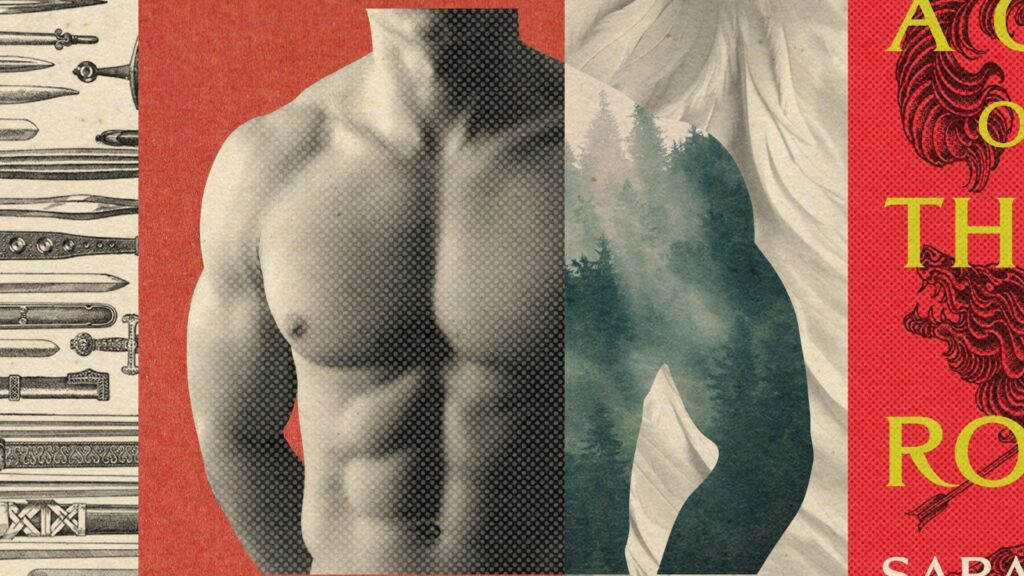Why Women Online Can’t Stop Reading Fairy Porn
It’s a tale as old as time — the heartwrenching, steam-inducing, bodice-clenching story of a woman falling head over heels in love with a man who’s more red flag than person. Except in the case of the best-selling book A Court Of Thorns And Roses and its subsequent series, author Sarah J Mass didn’t just use these tropes to establish herself in the romance market— she used fairy porn to revive an entire subgenre of publishing.
The name on everybody’s lips at the moment is “romantasy,” a blended genre of novels that has taken the publishing world by storm. While the phrase is the literal definition of a successful marketing term, romantasy books are easy to describe. Per their portmanteau, they combine traditional fantasy elements, like magical creatures or mystical words, with traditional romance formats, often sexually descriptive and explicit. (TikTok users prefer the phrasing “spicy.”) TikToks using the hashtag #acotar have skyrocketed to over a million posts and close to 9 billion views, which doesn’t even come close to the thousands of content webs that have spiraled from the book’s popularity. You can buy TikTok shop t-shirts that boast “The Bat Boys” (a group nickname for Mass’ sexy, winged, male characters) or find workout routines tailored to muscle requirements laid out in the books (you can’t fly without strong lats!). Or for the very brave, you can attend the copyright fiascos that are the ACOTAR-themed balls, black tie events complete with characters in book-specific cosplay. Combined with the sheer amount of book recommendations that include Mass’ 16 book catalog, this interest has all worked in tandem to boost the author to 38 million sales worldwide. But all of the buzzy marketing terms and facets of publicity can’t overshadow the main reason Mass is the reigning queen of romantasy: her books are familiar, straightforward, and easy to pick up. And as of last month, the best way to understand her book world just so happens to be reading every. single. one.
For those unaware of the general plot, A Court of Thorns and Roses is a spin on the classic tale of Beauty and Beast, following the story of a young human girl named Feyre falling in love with an immortal Fae lord. Feyre and her family live in a land that is definitely probably not England in an unspecified time where voting seems not to exist, but women can speak in public without being burned at the stake. Their human town borders Prythian, a magical land filled with mystical creatures and ruled by their overlords, the Fae. Feyre, who is 19 and a skilled hunter, is trying and failing to provide for her starving family. But when she goes hunting in the forest and kills a Fae disguised as a wolf, her punishment is to leave her life behind and live under the roof (and mercy) of Tamlin, the High Lord of the Spring Court. Once there, Feyre discovers that the brooding (and hot, don’t forget hot) Lord of the Spring Court can turn into a snarling beast, an angry temper that eventually turns her into mush when she realizes it hides his true feelings and anxiety about taking care of his people. Toss in a big curse with a deadline, an evil queen, a couple of monsters, an immortal man whose hottest kink is dating an illiterate 19-year-old, and at least four long and explicit sex scenes, and you’ve got the basis for a New York Times Bestselling novel.
In addition to the fact that later books double down on the porn aspects of Feyre and her friends’ lives, Mass’ books also come with a major plot shift in the sequel A Court Of Mist and Fury. (Spoilers ahead.) Think Tamlin’s growling, violence, and general control of Feyre was romantic? Well, psych motherfuckers! The prowling (and attractive) villain Rhysand is actually revealed to be Feyre’s true love. Mass also gets rid of any of the pesky ick of having an immortal fall in love with someone without a developed frontal lobe by introducing the concept of mates, a fantasy term for soulmates based on a biological imperative. Now, Feyre’s love isn’t just the romance of her dreams — it’s fate. This idea of a devotion stretching through time, war, and space defines many of Mass’ books — which is why it was no surprise when, in her new series Crescent City, she revealed that all of her fantasy series, previously thought to be unrelated, were part of a sprawling multiverse. Move over, Marvel. The Massassins — the name for Mass fans — are coming for your throne.
While Mass’ success in publishing is often described as overnight, a large aspect of her appeal is how long she’s been in the book world. The author published her first novel, Throne of Glass, a dark take on the Cinderella fairytale, in 2012, after versions of the book received major praise on indie fiction site FictionPress.com. Most of her books often situate themselves in common tales or lore — allowing readers to get past the necessary exposition-laden introduction that can kill interest in other fantasy books. When readers pick up a Mass book, there are familiar tentpoles studded throughout. See a brooding immortal male? You aren’t surprised when he falls in love with the main character. Read about an impending war? You know at the end that everyone who’s in love is making it out alive. It combines heavy escapism with romance’s promise that a happily ever after is waiting just through a battlefield. Mass’ books also rely heavily on strong and independent female characters, something that is often lacking in other popular fantasy books written by men. And, finally, ACOTAR often appeals to an audience of people who might not pick up traditional erotica — but feel perfectly comfortable lugging around one of Mass’s easily recognizable tomes. They’re like sexy stepping stones — and people keep coming back.
Mass has grown into a publishing giant, spawning the desire for romantasy books with similar themes and tropes. BookTok sensation Fourth Wing is just one example, a lush offering of romance between a young dragon rider and her brooding teacher at a dangerous, war-struck military college. But the rise of romantasy isn’t an anomaly. Rather, it’s just another turn of a common cycle in publishing. The years after the success of Twilight saw the book, film, and television industry dominated by vampire and werewolf lore. Suzanne Collins’ Hunger Games series jumpstarted dystopian youth fiction. Now there’s Mass and her laden cinematic universe of sexy, chiseled fae. We’ve been here before. We’ll probably be here again. But for the moment, it seems like the best bet for those confused by the internet’s devotion to faery porn might simply be to crack a book open and find out for yourself.





